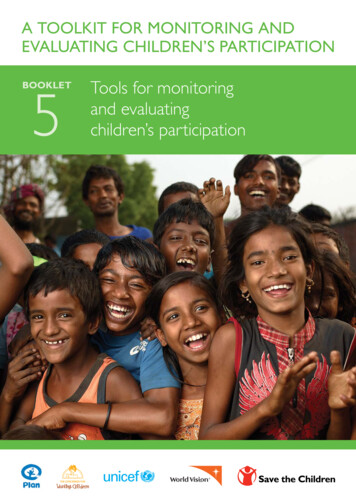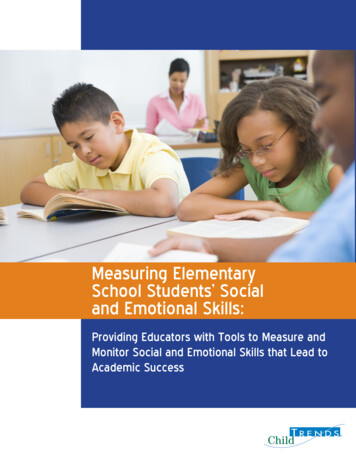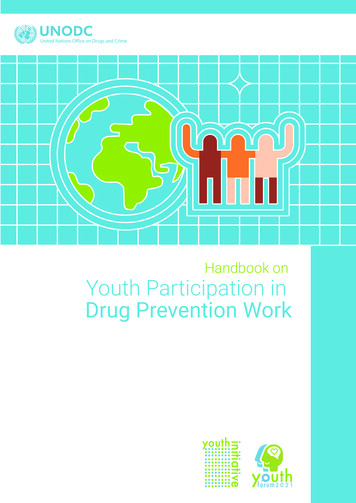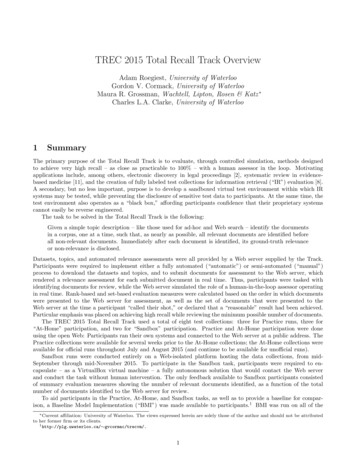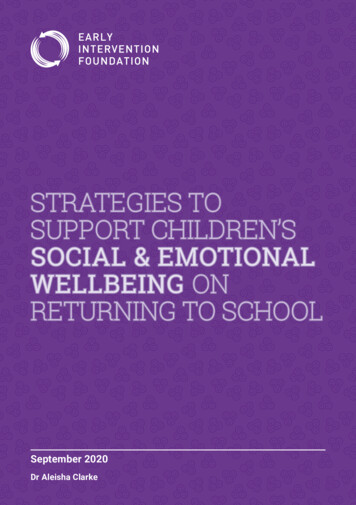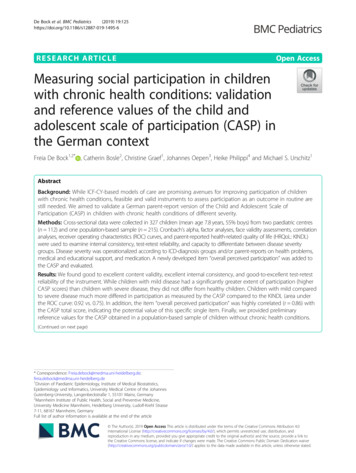
Transcription
De Bock et al. BMC Pediatrics(2019) EARCH ARTICLEOpen AccessMeasuring social participation in childrenwith chronic health conditions: validationand reference values of the child andadolescent scale of participation (CASP) inthe German contextFreia De Bock1,2* , Catherin Bosle2, Christine Graef1, Johannes Oepen3, Heike Philippi4 and Michael S. Urschitz1AbstractBackground: While ICF-CY-based models of care are promising avenues for improving participation of childrenwith chronic health conditions, feasible and valid instruments to assess participation as an outcome in routine arestill needed. We aimed to validate a German parent-report version of the Child and Adolescent Scale ofParticipation (CASP) in children with chronic health conditions of different severity.Methods: Cross-sectional data were collected in 327 children (mean age 7.8 years, 55% boys) from two paediatric centres(n 112) and one population-based sample (n 215). Cronbach’s alpha, factor analyses, face validity assessments, correlationanalyses, receiver operating characteristics (ROC) curves, and parent-reported health-related quality of life (HRQoL: KINDL)were used to examine internal consistency, test-retest reliability, and capacity to differentiate between disease severitygroups. Disease severity was operationalized according to ICD-diagnosis groups and/or parent-reports on health problems,medical and educational support, and medication. A newly developed item “overall perceived participation” was added tothe CASP and evaluated.Results: We found good to excellent content validity, excellent internal consistency, and good-to-excellent test-retestreliability of the instrument. While children with mild disease had a significantly greater extent of participation (higherCASP scores) than children with severe disease, they did not differ from healthy children. Children with mild comparedto severe disease much more differed in participation as measured by the CASP compared to the KINDL (area underthe ROC curve: 0.92 vs. 0.75). In addition, the item “overall perceived participation” was highly correlated (r 0.86) withthe CASP total score, indicating the potential value of this specific single item. Finally, we provided preliminaryreference values for the CASP obtained in a population-based sample of children without chronic health conditions.(Continued on next page)* Correspondence: medma.uni-heidelberg.de1Division of Paediatric Epidemiology, Institute of Medical Biostatistics,Epidemiology und Informatics, University Medical Centre of the JohannesGutenberg-University, Langenbeckstraße 1, 55101 Mainz, Germany2Mannheim Institute of Public Health, Social and Preventive Medicine,University Medicine Mannheim, Heidelberg University, Ludolf-Krehl Strasse7-11, 68167 Mannheim, GermanyFull list of author information is available at the end of the article The Author(s). 2019 Open Access This article is distributed under the terms of the Creative Commons Attribution 4.0International License (http://creativecommons.org/licenses/by/4.0/), which permits unrestricted use, distribution, andreproduction in any medium, provided you give appropriate credit to the original author(s) and the source, provide a link tothe Creative Commons license, and indicate if changes were made. The Creative Commons Public Domain Dedication o/1.0/) applies to the data made available in this article, unless otherwise stated.
De Bock et al. BMC Pediatrics(2019) 19:125Page 2 of 13(Continued from previous page)Conclusions: The German version of the CASP and the new item are efficient, valid and reliable measures of socialparticipation in childhood. The CASP-measured participation focuses more on attendance than on involvement intosocial circumstances of everyday life. To detect children with a high burden of disease on everyday life, the CASP maybe more accurate than HRQoL instruments such as the KINDL. As outcome measurement, the CASP may facilitate theimplementation of patient-centred paediatric health care.Keywords: Social participation, Children, Chronic health condition, Quality of life, Validation, Psychometric evaluationBackgroundThe prevalence of chronic health conditions in childrenhas dramatically increased in the last decades [1].Besides a rise of socially determined “new morbidities”(e.g. attention-deficit/hyperactivity-disorder, obesity), improved survival of perinatal, genetic and metabolic conditions (e.g. preterm birth, cerebral palsy, cystic fibrosis)explains this trend [2]. However, only few of these conditions resolve spontaneously or can be cured completely. Thus, the development of new, long-term,patient-oriented models of care will be a key challengefor the future [3]. In addition, outcomes other than having a diagnosis or not (e.g. ICD-10 Code [4]) or beingfree of symptoms are needed to guide future paediatrichealth care services.The World Health Organization anticipated this development by publishing the International Classification ofFunctioning, Disability and Health-Children and Youth(ICF-CY) in 2007 [5]. This classification scheme aims atestablishing a universal language to improve quality andrelevance of health care services for children withchronic health conditions and/or disability. Besidesphysical and mental functioning, the ICF-CY classifiescontextual factors, activities, and - as an ultimate goal ofmedical care – (social) participation. Although theICF-CY was published more than 10 years ago, systematic reviews showed that application and practical implementation of the ICF-CY is very limited in paediatrichealth care services and deserves more efforts [6].Within the ICF-CY, participation is broadly defined as“problems an individual may experience in involvementin life situations” and its theoretical construct covers 9distinct domains [5, 7]. However, the distinction betweenimpaired functioning, activities, participation, and quality of life is blurred and actual instruments do notclearly distinguish between these constructs according torecent WHO definitions [8]. In particular, the concept ofparticipation and its constructs according to the ICF-CYare only insufficiently transferred into scientific practice.In a recent systematic review evaluating methods in participation intervention research, five different themes ofparticipation could be identified in 25 articles analysed[9]. Two themes, attendance and involvement, were directly related to participation, while three themes wereonly related concepts (i.e. preferences, activity competence, and sense of self; [9]. This led to the propositionof a “family” of participation-related constructs, whereattendance and involvement seem to describe the essence of the participation concept while the relatedthemes such as preferences and activity competence arerather important means to enhance participation [9].With the ICF-CY defining participation as an ultimate goal and outcome measure of health care services,feasible, acceptable, valid, and cost-effective instruments to assess activities and participation in routinecare are needed. A recent review on children’s participation measures showed that most instruments camefrom the English-language literature, were rather long(mean number of items: 37), and assessed participation only with some items (mean proportion of itemscovering participation: 49%; [10]). Despite the ICF-CYbeing the conceptual basis for these instruments, onlythe Child and Adolescent Scale of Participation(CASP; 20 items; [11]) and the Participation and Environment Measure for Children and Youth(PEM-CY; 58 items; [12]) cover all nine domains ofactivities and participation as specified in the ICF-CY.Of the 20 CASP items, 1, 6, 4, 7, 9, 9, 2, 11, and 20items cover the ICF-CY domains d1, d2, d3, d4, d5,d6, d7, d8, and d9, respectively [10]. 25 and 75% ofthe items cover activities and participation,respectively. Activities and participation are assessedin the areas “home”, “community”, “school”, and “living activities”. The CASP may be seen asparticipation-centred outcome instrument and may bevaluable for participation intervention research.Thus, we aimed to establish a culturally adapted German version of the CASP to promote participation as anoutcome measure of daily health care and health careservices research in the German language area. Therefore, we applied it to parents of children with and without a wide range of chronic health conditions ofdifferent severity and assessed its validity and reliability.As pointed out by Rainey et al. [13], existing instruments(e.g. from the Anglo-American area) should be culturallyadapted and validated before its use in contexts that differ relevantly in terms of culture, health care and/oreducational system.
De Bock et al. BMC Pediatrics(2019) 19:125MethodsSettings and participantsThis study took place in three different settings resultingin two clinical and one population-based samples: i) anoutpatient paediatric neurology centre (clinical sample 1;SPZ Frankfurt/Main, Federal State of Hesse, Germany),ii) an inpatient paediatric rehabilitation clinic (clinicalsample 2; Klinik Viktoriastift Bad Kreuznach, FederalState of Rhineland-Palatinate, Germany) and iii)within the city limits of Mainz and the rural districtof Mainz-Bingen (population-based sample; FederalState of Rhineland-Palatinate, Germany). This approach was chosen to i) cover a broad range ofchronic conditions, living environments, and healthcare services and ii) test the CASP’s ability to differentiate between children with and without chronichealth conditions of various severities.The clinical sample 1 consisted of children with predominantly chronic neuro-paediatric conditions (e.g.cerebral palsy, epilepsy, neuro-genetic conditions) andwas recruited via convenience sampling at regularlyscheduled appointments at the outpatient centre between November 2015 and April 2016. The clinical sample 2 was a convenience sample of children andadolescents with a broad spectrum of different chronichealth conditions such as diabetes, obesity, andattention-deficit/hyperactivity-disorder (ADHD), whowere recruited at the inpatient clinic between Marchand June 2016. The population-based sample consistedof participants of an ongoing prospective cohort study ofchildren officially registered for school entry in autumn2014 [14]. Recruitment for the current study was performed at the end of first grade in June 2015.Inclusion criteria for the clinical samples were: 3–11years of age, a certified medical diagnosis, and sufficientGerman language skills of parents and children. Inclusion criterion for the population-based sample was active participation at the time of recruitment in theunderlying cohort study. Written informed consent wasobtained in parents and in children of more than 8 yearsof age. The study was approved by the Medical EthicsReview Board of the Medical Faculty Mannheim at Heidelberg University (2015-550 N-MA), the Ethics Committee of the Federal Physician Chamber of Hesse(MC180/2015) and the Ethics Committee of the Regional Medical Association of Rhineland-Palatinate(837.544.13 [9229]).Study design and proceduresA prospective validation study was performed. After instrument translation, validity and reliability was assessedin using cross-sectional (validity) and longitudinal (reliability) study designs. Data were largely obtained byquestionnaires, which were either handed out in personPage 3 of 13(e.g. at regular appointments in the clinical samples)or mailed to parents in the population-based sample.Parents took about 10–15 min to fill in the questionnaires and were asked to hand back the questionnaires after the appointment or send it back to thestudy centre using prepared stamped envelopes.Beyond this survey, detailed information on chronichealth conditions was retrieved either from the localclinical information system (clinical samples) or fromthe preschool examination database (population-basedsample) provided by the regional Department ofPublic Health (County Government Mainz-Bingen).Assessment of social participationSocial participation was measured using a Germanversion of the CASP [11]. The CASP is a 20-items4-scales parent-report instrument covering attendanceand involvement in the areas “home”, “community”,“school”, and “living activities”. The instrument measures the extent to which children of 3 to 18 years ofage participate in activities in comparison to healthychildren of the same age. Due to its shortness, however, the CASP does not differentiate between different aspects of participation such as attendance andinvolvement. Responses are rated on a 4-point scaleranging from 4 “age expected” “(i.e. full participation)”and 3 “somewhat limited” to 2 “very limited” and 1“unable to participate”. An additional fifth responsecategory of “not applicable” is provided for all items.In addition, the instrument offers three open-endedquestions that can be used for individualizedfamily-centred care planning. The original CASP wasshown to have high reliability (Intra-class coefficient 0.94; Cronbach’s α 0.96) and usefulness to discriminate between children with and without disabilities[11, 15]. Scores are summed up and calculated forthe total scale and 4 subscales [16]. The scores of thescales range from 0 to 100%, higher scores therebyindicate more favourable participation.The original English version was translated andback-translated by two independent translators as requested by international standards [17]. Based on comparisons of translated versions, a final version wasconsented after discussion among translators and anadditional expert in the field (HP). This version was thenapplied to seven parents and nine experts in the field toassess cultural and content appropriateness. Based onthe feedback, further cultural and language adaptationswere undertaken to increase acceptance in German language settings. Cultural adaptions encompassed primarily achange of illustrative examples for activities as well as theuse of simplified vocabulary to make the items easier tounderstand for parents with migrant background. For example, leisure-time physical (German: “Kinderturnen”) and
De Bock et al. BMC Pediatrics(2019) 19:125musical education (German: “Musikschule”) were added asimportant additional after-school activities.Assessment of chronic health conditionsThe identification of chronically ill children was basedon the following data available: i) ICD-10 codes from theclinical information systems (clinical samples), ii)parent-reported doctor diagnoses from the preschoolexamination database (population-based sample), and iii)information on special health care needs as assessed inthe preschool examination of Rhineland-Palatine (allthree samples).As there was no international definition for the identification and severity rating of chronic health conditions,we developed an algorithm based on the criteria published by Perrin et al. [18] and the ICF principals. Ratings were performed independently by two medicalexperts (FDB (author, pediatrician), CS (speech therapist)) and reviewed by a third one (HP (author,pediatrician, pediatric neurologist)). The followingchronic health conditions were considered: combineddevelopmental problems, obesity, ADHD, behavioral andconduct problems, cerebral palsy, epilepsy, autism, genetic syndromes, intellectual disability, and former cancer.First, presence of one of the above chronic health conditions was determined by reviewing the ICD-10 codesand parent-reported doctor diagnoses. Second, based onICD-10 codes and doctor diagnoses, the health conditionwas rated as severe, if long-lasting, irreversible structuraland functional deficits were present or could be expected. Otherwise, the condition was rated as mild.Third, needs and uptake of prescribed medication for amedical problem were evaluated. Depending on thepresence of such a medication, the medical conditioncould be upgraded (e.g. from no to mild or mild to severe). In a fourth step, needs and uptake of physical, occupational, or speech therapy were evaluated. Dependingon the presence of such a treatment, children wereupgraded from “without chronic condition” to mildhealth condition, to also include conditions not yet recognized as diagnosis. Last, needs and uptake of social oreducational support or mental health services were evaluated. Again, depending on the support, the childrenwere upgraded from “without chronic condition” to mildhealth condition. The identification and rating steps ofthis algorithm are illustrated in Fig. 1. This algorithmallowed the combination of information of the conditionitself with information the condition’s consequences andimpact and the actual health care use.Assessment of health-related quality of lifeHealth-related quality of life (HrQoL) was measured usingthe KINDLR parent-proxy instrument [19]. The KINDLRis a 24-items 6-scales parent-reported instrument coveringPage 4 of 13the domains “physical wellbeing”, “emotional wellbeing”,“self-esteem”, “family”, “peers”, and “pre-school/school”.Responses are rated on a five-point scale ranging from“never” and “rarely” to “sometimes”, “frequently” and“always”. Comparable to the CASP, a total scale (scoresrange from 0 to 100) and subscales are available.Results for validity and reliability of the instrument(Chronbach’s α 0.85 for the total scale) have beenpublished elsewhere [20].Although the KINDLR was developed as a measure ofHrQoL, only 36% of its items were found to be congruent with the WHO HrQoL definition [8]. In contrast,more than 50% of the items were congruent with one ofthe ICF-CY domains [8]. We, hence, expected somepositive relationships between parent-reported CASPand KINDL measures, although the concepts of HrQoLand participation are theoretically quite different.Assessment of socio-demographic factorsAge, sex, and migrant background of the child as well asparental education was obtained by additional questionnaire items. Parental education was defined based uponthe highest parental level of education achieved, according to international standard classification of education(ISCED; high ISCED level 4–5, medium ISCED level3, and low ISCED levels 0–2). Migrant backgroundwas operationalized based on the recommendation bythe German National Statistics Bureau [21], which accounts for parental nationality and country of birth.Validation process and statistical analysisDescriptive statistics (n and percentage, mean and standard deviation) were used to describe the distribution ofsocio-demographic and clinical factors among samplesand disease severity groups (Tables 1 and 2).Content validity was assessed using a face-validity approach. Eight experts (2 paediatricians, 2 speech therapists, 2 physiotherapists, and 2 occupational therapists)rated comprehensibility, importance, and conceptualcomprehensiveness of the instrument on a 5-point ratingscale ranging from “not at all” to “very much”.Exploratory factor analysis (EFA) using a promax rotation was performed to analyse the underlying structureof the CASP items. Due to missing values (mostly because parents chose the “not applicable” option), an imputation technique with an expectation-maximization(EM) algorithm was applied [22]. This method wasfound to provide a better basis for EFA than other moretraditional methods (e.g. complete case analysis or meanimputation [23]). To specify nominal sample size, we usethe column-wise minimum, which is defined as thenumber of complete cases for the variables with themost missing values [22]. The Kaiser criterion (eigenvalues 1) was applied to define the number of factors.
De Bock et al. BMC Pediatrics(2019) 19:125Page 5 of 13Fig. 1 Flow chart on the operationalization of children with chronic health conditions and different disease severity (for detailed description ofoperationalization see methods)Finally, internal consistency of the CASP was analysedusing Cronbach’s alpha for both, the total scale and allsubscales.In absence of a German reference standard for measuring participation, relationships between CASP andKINDLR measures were investigated. Therefore, a singlequestionnaire item covering parental perceived overall social participation ranging from 1 “unable to participate” to4 “age expected” was introduced and Pearson’s correlationcoefficients between CASP scales, KINDLR scales, andperceived overall participation were calculated.Test-retest reliability was assessed by repeated administrations of the instrument in children from the clinicalsample 1 with a time lapse of 2 to 4 weeks between measurements. Therefore, intra-class correlation (ICC)coefficients were calculated for the CASP total scale andall subscales.CASP reference values were calculated based on thepopulation-based sample and contrasted to the results ofthe clinical samples. The association between disease severity and participation was analysed in using linear regression analysis with the CASP total scale as thedepending variable and disease severity, age, sex, andparental education as independent variables. The abilityof the CASP to classify children according to their disease severity was investigated in using receiver operatingcharacteristic (ROC) curves and area under this curve(AUC). Results for the CASP were contrasted to resultsfor the KINDL. All statistical analyses were performedusing STATA 13.1 [24].
–18 (21.43)24 (28.57)22*** (78.57)1*** (3.57)4*** (4.76)low73.77*** (9.81)HrQoL10 (11.90)–(14.29)71.31*** (13.48)91.70*** (9.32)4***215 (65.75)110 (51.16)(63.72)–3 (1.40)83.30*** (8.02)–4 (1.86)8 (3.72)––n (%) missingvalues98.16*** (5.80)6*** (2.79)68*** (31.63)137***16*** (7.44)**7.27*** (0.32)n (%) or mean (SD)–1 (3.57)8 (28.57)––n (%) missingvaluesPopulation-based sampleCASP Child and Adolescent Scale of Participation, HrQoL Health related Quality of Life, SD Standard deviation; *Age-adjusted values; † p .05;** p .01; *** p .00175.58*** (19.56)CASP5 (5.95)36*** (42.86)medium(46.43)39high***3*** (10.71)Parental education10 (35.71)femaleyesMigrant background**40*** (47.62)8.31*** (2.38)–6.21*** (1.94)**28 (8.56)n (%) or mean (SD)n (%) missingvalues84 (25.69)n (%) or mean (SD)Clinical sample 2SexAge (years)N (%)Clinical sample 1Table 1 Description of study population by sample79.99 (10.24)91.80 (14.87)11 (3.36)126 (38.53)180 (55.05)59 (18.04)144 (44.04)7.08 (1.36)n (%) or mean (SD)327 (100.00)Total sample13 (3.98)–10 (3.06)34 (10.40)––n (%) missingvaluesDe Bock et al. BMC Pediatrics(2019) 19:125Page 6 of 13
84.41*** (7.01)HrQoL1 (0.97)–4 (3.88)75 (43.10)78.83*** (10.83)94.65 *** (8.77)6 (3.45)7 (44.25)86 (49.43)31*** (17.82)5 (2.87)–5 (2.87)18 (10.34)––n (%) missingvaluesCASP Child and Adolescent Scale of Participation, HrQoL Health related Quality of Life, SD Standard deviation, *Age-adjusted values, † p .05;** p .01; *** p .00199.11*** (2.48)4 (3.88)lowCASP66 (64.08)29 (28.16)Parental education–3 (2.91)54 (52.43)9*** (8.74)highMigrant background†7.13† (1.37)–7.23† (0.29)†174 (53.21)n (%) or mean (SD)n (%) missing valuesn (%) or mean (SD)Mild chronic health condition103 (31.50)mediumfemaleyesSexAge (years)N (%)Without chronic health condition (healthy)Table 2 Description of study population by disease severity15 (30.00)74.02*** (10.21)66.86 *** (20.26)1 (2.00)20 (40.00)28 (56.00)19*** (38.00)†6.61† (2.18)n (%) ormean (SD)50 (15.29)7 (14.00)–1 (2.00)13 (26.00)––n (%) missingvaluesSevere chronic health condition79.99 (10.24)91.80 (14.87)11 (3.36)126 (38.53)180 (55.05)59 (18.04)144 (44.04)7.08 (1.36)n (%) ormean (SD)327 (100.00)Total13 (3.98)–10 (3.06)34 (10.40)––n (%) missingvaluesDe Bock et al. BMC Pediatrics(2019) 19:125Page 7 of 13
De Bock et al. BMC Pediatrics(2019) 19:125Page 8 of 13Table 3 Exploratory factor analysis using a promax rotation (n 290)CASP itemsFactor 1Home: Social/leisure (family)0.86Home: Social/leisure (friends)0.90Home: chores/responsibilities0.86Home: Self-care0.87Home: Mobility0.81Home: Communication0.85Community: Social/leisure (friends)0.86Community: Structured activities0.88Community: Mobility0.86Community: Communication0.88School: Educational activities0.80School: Social/leisure (students)0.86School: Mobility0.85School: Using educational Materials0.88School: Communication0.83HCLA: Household activities0.84HCLA: Shopping/managing money0.82HCLA: Managing daily schedule0.84HCLA: Using transportation0.79HCLA: Work activities0.86Variance explained88.7%CASP Child and Adolescent Scale of Participation, HCLA Home and CommunityLiving ActivitiesResultsDemographic and clinical characteristics of the sampleIn total, 327 children were enrolled into the presentstudy (clinical sample 1: 84 children, clinical sample 2:28 children, population-based sample: 215 children).Demographic characteristics stratified by sample aregiven in Table 1. In total, 103 children (31.5%) were classified as without chronic health condition, while 174children (53.2%) were categorized as mild chronic healthcondition and 50 children (15.3%) as having a severechronic health condition. Demographic characteristicsstratified by disease severity are given in Table 2.Here: Tables 1 and 2.Content validityComprehensibility of the final German CASP items (seeAdditional file 1) was rated to be 3.8 (i.e. 76% of a maximum of 5) for subscale “home”, 4 (80%) for subscale“community”, 4.7 (93%) for subscale “school”, and 4.6(91%) for subscale “living activities”. Importance ratingswere as follows: 4.7 (i.e. 93% of a maximum of 5), 4.6(91%), 4.7 (93%) and 4.4 (89%) for all subscales, respectively. Finally, conceptual comprehensiveness was rated4.4 (88% of a maximum of 5), 4.1 (82%), 4.2 (84%), and4.6 (91%) for all the subscales, respectively. These resultscorresponded to good to excellent content validity.Underlying scale structure and internal consistencyResults for the EFA are provided in Table 3. Thecolumn-wise minimum was n 290. The Kaiser criterionimplied an underlying one-factor structure. This factorcontributed to 88.7% of the variance explained. Cronbach’s alpha for both, the total scale (α 0.98) as well asfor the subscales A-D (A: α 0.94, B: α 0.92, C: α 0.93, and D: α 0.93) indicated excellent internalconsistency.Relationship with HrQoLWe found a moderate positive correlation between theCASP and the KINDLR total scales in the total sample(n 314, r 0.45, p-value 0.001). The correlation washighest in children with mild conditions (n 169, r 0.50, p-value 0.001), lower in children with severe conditions (n 43, r 0.35, p-value 0.022) and weak inchildren without chronic health conditions (n 102, r 0.19, p-value 0.062). There was an excellent correlationbetween the CASP total scale and the results for the single questionnaire item covering parental perceived overall social participation (n 308, r 0.86, p-value 0.001).Test-retest reliabilityTest-retest reliability was investigated in 22 children. Ofthese, 19 had a chronic health condition (e.g. developmental and behavioural problems, epilepsy, cerebralpalsy, as well as genetic disorders). ICC for the CASPtotal scale was r 0.97 (p-value 0.001). For the CASPsubscales, the ICC ranged from r 0.86 (p-value 0.001;subscale D) to r 0.96 (p-value 0.001, subscale B),thereby indicating very good to excellent test-retest reliability. Reference values and association with diseaseseverityBased on the population-based sample of 215 children,mean CASP total score was 98.2 ( 5.1), with a high leftskewness ( 8.0) and kurtosis (82.6), and the followingpercentiles (5th: 92.1, 10th: 95, 25th: 98.7, median: 100).Children with mild chronic health conditions had distinctly higher CASP values (mostly 80) than childrenwith severe chronic health conditions (between 50 and80: see Fig. 2). In line with Fig. 2, ROC analyses demonstrated that children with mild compared to severechronic health conditions differed much more in CASP(AUC .92), than in KINDL (AUC .75, p-value for difference 0.001, Fig. 3).Compared to children without chronic health conditions, children with mild conditions had 3.4 points( 1.2; p-value 0.01) and children with severe conditionshad 28.7 points ( 1.9; p-value 0.001) lower values regarding the CASP total scale (Table 4). The differences
De Bock et al. BMC Pediatrics(2019) 19:125Page 9 of 13Fig. 2 HrQoL and CASP values of chronically ill children in the sample, stratified by disease severity. 1CASP Child and Adolescent Scale ofParticipation; 2HrQoL Health related Quality of Lifeacross groups remained after adjusting for age, sex, andparental education.DiscussionAfter translation and back-translation as well as cultural pretesting with consecutive text adaptation, this study investigated psychometric properties of a newly-developed Germanversion of the parent-reported CASP instrument (seeAdditional file 1) in a large and diverse study sample. Wefound good to excellent content validity, excellent internalconsistency, and good to excellent test-retest reliability of theinstrument. We provided reference values obtained in apopulation-based sample of children and investigated the effects of mild and severe chronic health conditions on CASPresults in comparison to a related HrQoL instrument. Finally, a one-item short version that was intentionally addedto the CASP to assess overall perceived participation washighly correlated with the CASP total score, thereby indicating the potential value of this specific item on global perceived participation. In summary, we could convincinglydemonstrate that the German CASP is sufficiently valid andreliable to be used in clinical health care and future studies.Fig. 3 Ability to differentiate between mild and severe chronic disease, for both the CASP and HrQoL. 1CASP Child and Adolescent Scale ofParticipation; 2HrQoL Health related Quality of Life
De Bock et al. BM
Conclusions: The German version of the CASP and the new item are efficient, valid and reliable measures of social participation in childhood. The CASP-measured participation focuses more on attendance than on involvement into social circumstances of everyday life. To detect children with a high burden of disease on everyday life, the CASP may
